About this blog– This is a detailed itinerary to explore Fes in three days and its Ancient Medina. Fes is an oft-overlooked city of North Morocco where time stands still. The donkey carts, the royal palace, the wooden workshops- all of them tell the tale of a time bygone. Unhurried and secure, Fes has witnessed a sprawling past since the Marinid dynasty. Centuries of history has been centered around Oued Fes (the Fes river on the banks of which old Medina is). You should definitely include Fes in your Morocco itinerary.
Read all my travel blogs on Morocco here.
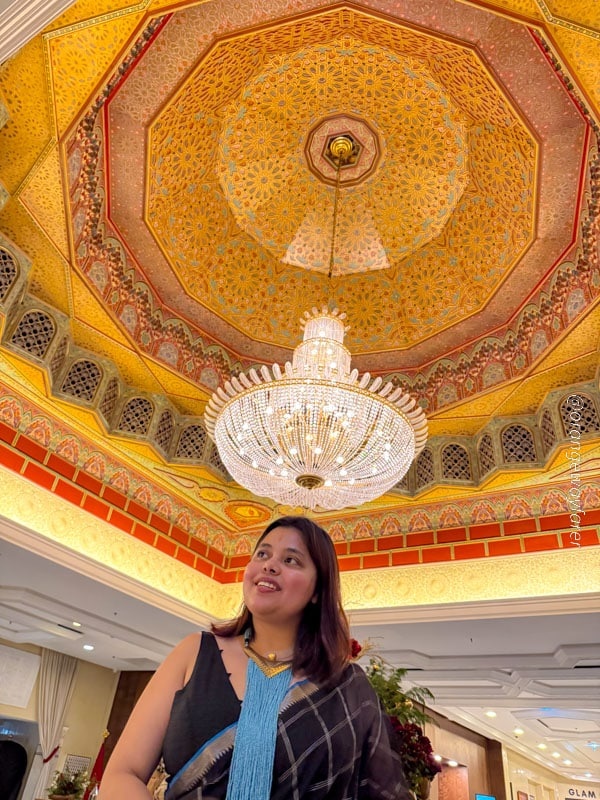
Fes (also pronounced as Fej) was the last stop of our 4 days long private trip to the Sahara Desert. On the last day, we left our desert camp at 10 am, changed a bunch of vehicles, made a few quick pit stops, and saw the dunes cave in to rocky Hamada which gradually ascended to High Atlas.
Snow glistened at the top of the mountains while a dramatic road took us to the deep of the North, where Fes City is. I almost thought we came back to Darjeeling. The valley was simmering with flickering lights as we descended down the Atlas Mountain.
Fes quickly became my favourite city of Morocco. Not only it is one of the biggest and most populous urban areas of Maghreb but it is unapologetically original and authentic. In tune with true Moroccan hospitality, parts of which we experienced at the nomadic Berber villages in the desert.
What I loved about Fes is that Instagram has not reduced the city to photo spots. Yes, there are overcrowded tanneries that stink of labor exploitation ritual which has hardly changed over a thousand years, the narrow streets felt like shrinking with walking tours, and a few occasional appearances of scammers who would demand money for showing a way out when maps failed. But Fes also gives you an experience where you are not acutely aware of being a tourist. You are not always sticking out. The city life continues in its own rhythm. And an old beautiful city, nonchalant about tourists’ existence.
I write all this to convince you to take that trip to Fes. Book the night train to Fes. Once the tunnel construction beneath Atlas mountain is complete you can speed past the mighty Atlas even.
Fes has withstood waves of dynasty changes, starting from Cordoba Caliphates and Tunisian Fatimids to various Berber tribes to the most recent bout of French Colonists. However, it was the Algerian Marinid dynasty that took Fes to the zenith of the Golden age, when the city was seated at the glorified top of the capital of the country.
For long, Fes has been the multicultural seat of Northern Morocco, with Jewish and Muslim traders sharing trading prowess. The French shifted the capital from Fes to Rabat, and built more urban architecture beyond the walled Medina, known as Ville Nouvelles.
For the longest part of the history, Fes played the key role in Morocco’s intellectual and religious sphere, with a number of Masradas (Islamic schools) where scholars from Maghreb would ruminate over teachings of Quran. Fes el bali (the old City) houses a significant population till date where the year 2025 and its technological know-how is yet to find a place. It is a maze of narrow alleyways and intricately connected palatial buildings.
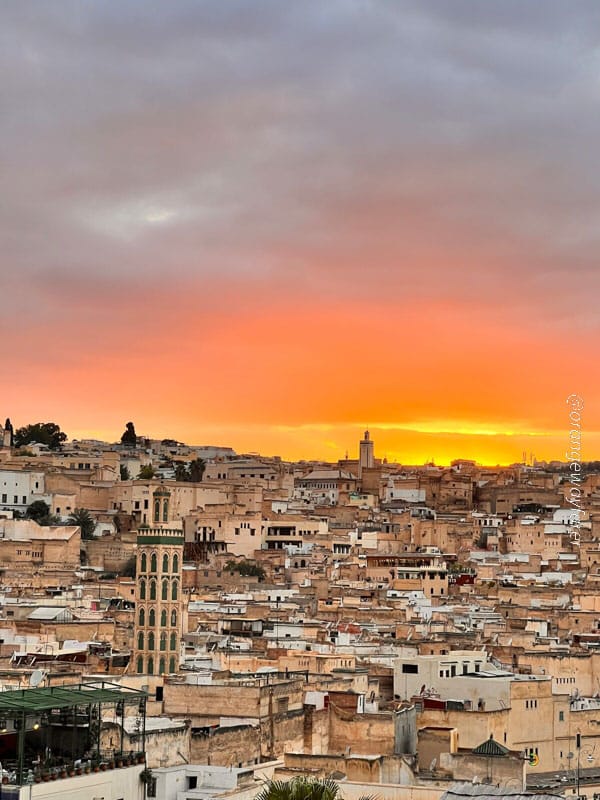
For someone who has a bit of interest in history, Fes is a gold mine. Visit during the dry months from Oct to Febuary, when the weather is mild and daylight is ample.
In Fes, time stands still in Morocco.
Specifically in the Fes Medina.
We walked the alleyways of Fes from the start of the day, before bus loads of tourists visited. When they did, Medina breathed heavy, for there was no space for a fly to sneak in.
Before arriving at Fes, my knowledge of Medina was largely shaped by the tourist trap that Marrakech Medina is. I tried hard to love Marrakesh but heart wants what it wants. It s=did not agree with Marakkesh. But Fes was love at first sight.

How many days do you need to explore Fes
Those who come to see the Sahara desert primarily, will stop their journey at Merzouga and head back to Marakkesh. But if you have a little while and want to explore the north of the country, Fes is probably going to be your base
You need one whole day to explore Fes, to see the sunset and frolic around Medina. If you have another day or two, explore the surrounding area, the cute little town of Chefchaouen .
If you are okay to slow down in Fes, I would prefer this Medina over Marrakesh anyday. Fes is not really known as a digital noad hotspot like Tangier or Casablanca is. However is it very well connected with European cities (3 hours flight) or other cities of Morocco internally. Casablanca which is a pretty industrial town is located at a short three hours distance by road from Fes.
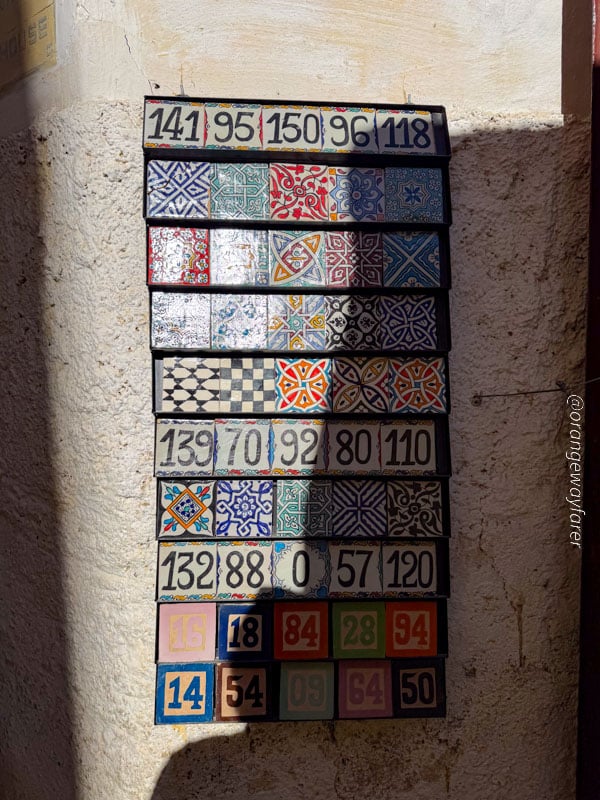
Things to know before planning a trip to Fes
Like the rest of Morocco, having a guide will save you a bit of a hassle in Fes. However even if you do not have one, and have bit of an experience in northern African countries, Fes is not too difficult to navigate. I would definitely recommend a guide while exploring the Sahara desert. Fes on the contrary is pretty urban.
I had only a couple of days in Fes. I would have preferred to join one of the walked that explored the old part of the Medina.
Boasting of close to 10,000 alleys, Fes is the largest paved car free pedestrian zone. May be you will see a few donkeys in Medina. But cars? Nope! I walked in the medina since the break of the dawn, in the areas where tourists hardly visit. I saw children getting readied for school. Breadshops starting the day’s business. Locals watering the dusty roads leading to their small business shops. All these and no trace of a car! No wonder Reddit goes berserk discussing why time stands still in Fes!
The Fes Medina has it all. Funky restaurant that the Ruined Garden is, STinky tanneries standing still since thousand years, madarasa, Attar shops, pockets of local residencies where tourists wont find any spot, historic wooden workshops. You need to plan your visit based on where you want to go and how!
I followed the map I prepared but I would have liked to hire a guide or join a walking tour. It is a historic city with trivia at every stop. It is nice to have a local guide explain stuff to you, especially if you are visiting Fes as a solo woman traveler.
While it was nothing like Marrakesh where people would appear out of nowhere and try to talk to you to get some dollar bills, or even touch yu inappropriately, I did not encounter persistent scammers in Fes. Except one boy, whom I had asked where is the main road. He made some signs and asked for money. I remember giving him equivalent to a USD and he demanded I give him 10 USD. I said, dude I am not India it is a lot of money for us! Well, he seemed to be butthurt but did not persist any frther!
Morocco is the only place where I never said I live in New York City! Nope! They would rip you apart!!!
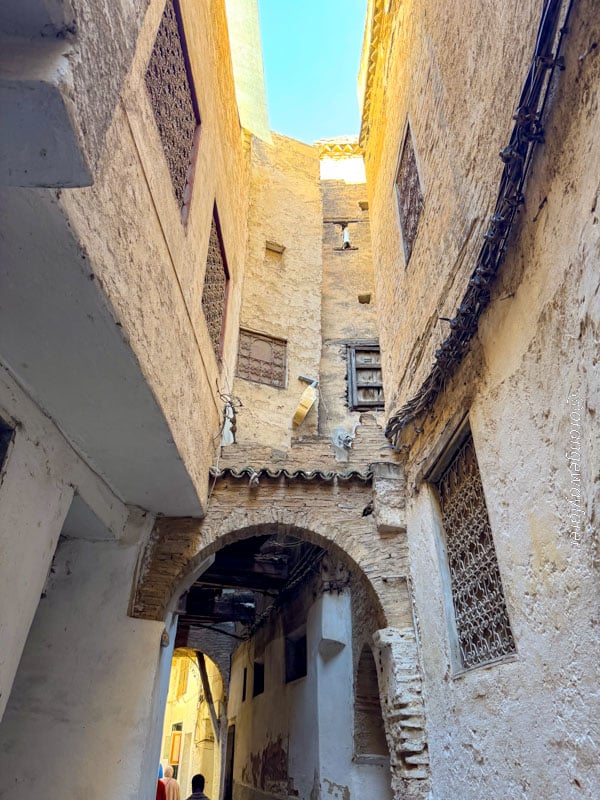
Where to stay when traveling to Fes
If you are okay walking the Medina, I would definitely recommend staying inside a Riad. They are beautiful, homely and have all the authentic feels. But we had luggage and we had experienced a Riad stay in Marakkesh already. We stayed at Marriott Jnan Palace. This stay, while a bit further from the city center, rejuvenated us in every sense!
I do have plans to visit Algeria and Tunisia in the coming years. Both the countries have Riad stay options where I would explore some more Maghreb hospitality.
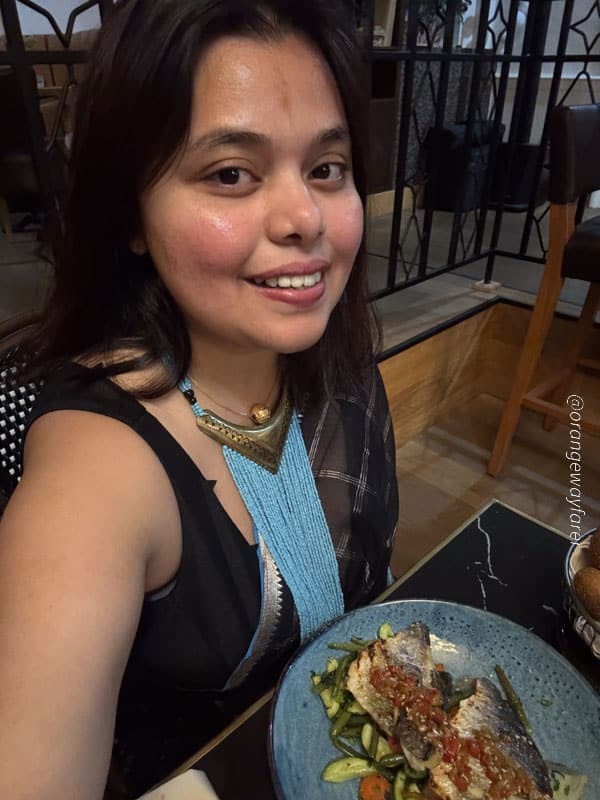
Things to do in Fes in 3 days- an Ideal Fes Itinerary
- Day 1 in Fes: Fes el Bali, Chouara Tannery, Kairouine Quarter ,Ruined Garden restaurant
- Day 2 in Fes: Royal Palace, Roman Ruins of Volubilis, Riad Stay, Jewish Quarter
- Day 3 in Fes: Day trip to Chefchaouen
This is a rather relaxed itinerary for Fes for Three days.
Fes Medina- the World UNESCO heritage site
I absolutely loved Fes medina. Endless shops ,endless products on display. The lamps. The drums. The colours! A riot of colour! The aroma of Ittar. The people. I could walk and gladly be lost in that maze over and over again.
The Fes Medina is a UNESCO World Heritage site with more than 9000 alleyways intertwined with old, really old residential buildings, an array of tourist facing business and artistic quarters that are alive since centuries.
For me it was a love at first site. Also the fact that I did not stay inside the Medina made me feel I am loosing path on every other step. The Medina is a labyrinth. It is designed in a way that modern map images fail to take you ahead. You have to rely on the locals. A nod a point finger a glance of an eyesight comes at a price here, please remember.
Since this is a car free zone, it is easy to walk around.
Actual people live in the Old City of Fes, the Medina we are discussing. School is run here. Not every quarter is serving tourists which is why Fes Medina creates an impact like any honest authentic experience does!
While walking down the narrow alleys, I came across a place covered with bamboo. Apparently, that is how it used to be a thousand years ago! UNESCO has actively worked towards restoration and preservation of this medieval Islamic city, but parts of it retain its honest authentic self where 2025 has not found a way in yet!
The best part of Fes Medina is while exploring the Old City, you will come across a plethora of Madrasa, old Quranic residential school, some of which are partly opened for visitors, some have exclusive access to Muslims only. The Zelig tiles, the Moorish Wall Arches are distinct to this area.
Following are the point of interests that I had selected for our walk!
Bou Innia Madrasa
One of the oldest Quran schools in the country, Bou Innia Madarasa is the start of Talaa Kebira, one of the arteries of Fes Medina. The Marinid Sultan patronized the make of a number of Islamic schools to bring in Sunni influence in the region. Bou Innia Madrasa, which also assumed the role of “Friday Mosque” of the locality, slowly gave in to the shadow of Madrasa Qarawiyyin. More on that later.
Today, Bou Innia Madrasa stands as one of the most prominent mosques of the Old Medina. From the Blue Gate, you see the minaret of this mosque.
Bou Innia has extensive tile work and has been restored twice in recent history. It is said the Sultan frowned when he was presented with an extensive list of expenditure while making this madrasa. “What is beautiful is not expensive, no matter how large the sum.” were his words. You can imagine how far the Marinid architects would go to beautify this monument.
Right next to it the Dar Al Maghana, the now defunct water clock. Although parts of it have been restored, the water facades have been removed. Modern world apparently lost the knowhow to run the water clock.
As an Indian who grew up in cities with a number of mosques, I am used to be able to visit the mosques of historic interest. I am an atheist however culturally I am like any other Indian, at least to a large degree and I don’t have any qualms visiting mosques or places of worships of any religion. From that place, the non-Muslims not allowed inside board in front of every mosque in Morocco barring the new one at Casablanca was of a case of contrast. Why non-Muslims cannot enter the mosques? Especially when these are the epitome of medieval Islamic art and culture. Delving deep into the matter, I figured the rules were implemented by the French protectorate during 18th century. Centuries passed, the French left, but the rule stayed.
Al Attarine Madrasa
Walking down Rue Tala’a Kebira, right next to Qarawiyyin Universeity, you will come across high-standing walls of the 700 year old Medersa al-Attarine. From outside appearance, Al Attarine would not seem striking. But once you have crossed the threshold and entered the courtyard, you will stand in awe in front of the exquisite artistry of Marinid dynasty!
For a meagre USD 2 entry ticket, you can explore the court yard which showcases some of the best metalwork of Islamic world. I recall seeing parts of it Cairo, Agra and in pictures of Ifsahan. You can climb up the stairs and visit the 30 odd rooms where approximately 60 students from yesteryears would rest for the night.
The notable architectural style includes “lambrequin” or muqarnas arch that traces back its root in Iberian (now extinct) style. In India, you can spot them at Akbar’s tomb Agra. I particularly visited to see this arch (Muqarna vault), which found its origin back in 11th century in Iraq, North Africa, Iran, Central Asia, and Upper Egypt.
The wealth of decoration with The ornate metalwork, black cursive calligraphy will bring you closer to the memories of Alhambra (14th century) in Granada, Spain. the Marinid era Bronze Chandelier calls for attention. It is said that the Marinid invested heavily in the madrasa and adjacent area to influence with the Sunni tradition in contrast with the Sufi tradition prevalent in the land at that time.
The famous mathematician Ibn al-Banna from 14th century attended this Madrasa. We also spotted a mashrabiya, a wooden balcony producing as a small window from the upper floor.
The Madrasa is housed at the historic spice and perfume souk in Fez, thus earning it a name of “the madrasa of the perfumers,”
While exploring this area, I discovered a cute little ice cream shop named Bel Lamlih, which I can not recommend enoygh!
In the area, you will come across other Madrasa like the Saffarin and the Mesbahiyya, still operational among the Qur’anic students and is an integral part of the community life.
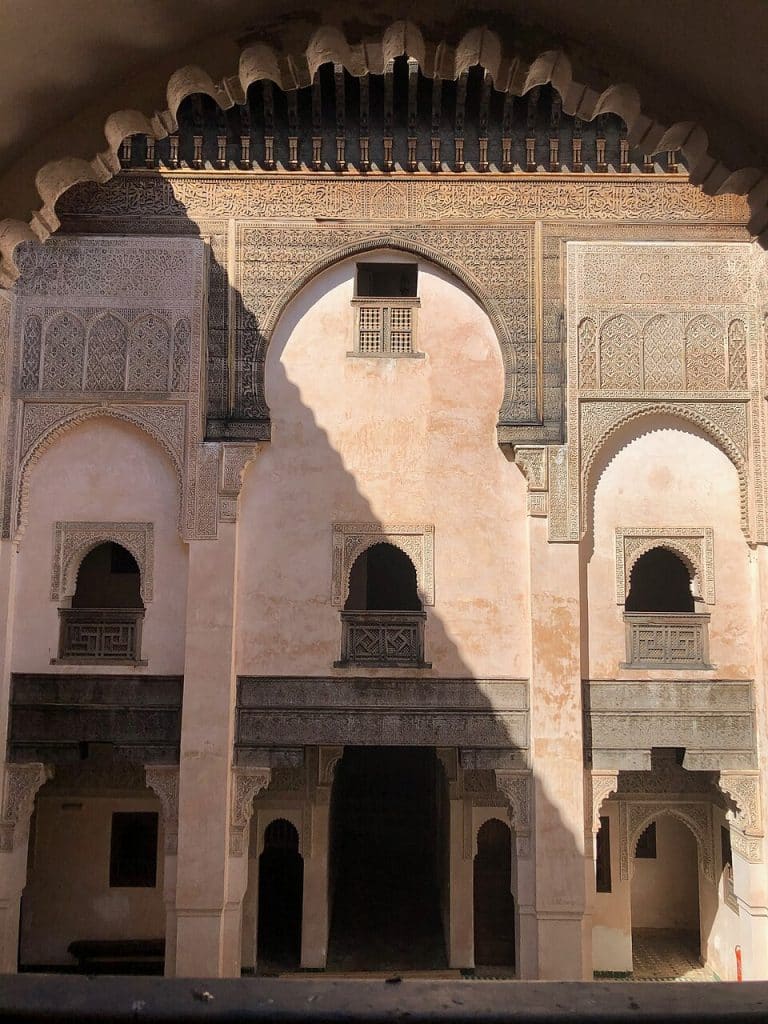
University of al-Qarawiyyin (also known as Kairaouine Madrasa)
Never did I ever imagine that Morocco would show me the oldest continually run educational institute of the world, which was originally established by a woman! Yes, you read that right!
It was first established by the lady named Fatima Al Firhi who immigrated to Morocco from Tunisia with her own community. The mosque bears semblance to the famed Mosque of Kairouan Tunisia.
Later, the sultans introduced science and other streams in the curriculum, and it quickly reached the zenith of popularity among the many Universities of Fes Medina.
Too bad, the University has entry limited to Muslims only.
What I gathered was the Fes madrasas have limited access to Muslims only as a result of the decree issued by the French colonial rule. The French specifically wanted places of Islamic worship be confined to Muslim community only, which is not the case at many other countries in the Arab world. Morocco continues with that ruling.
Mausoleum of Moulay Idriss II
Visit limited to Muslims only. Dedicated to the founder of Fes City. You can stand in front the entry gate and admire the beautiful facade of the religious condition comes in your way! It is part of the Qarawiyyin University complex.
Place Seffarine
This part of the Fes Medina souks, wrapped in hot copper foil, is a burst of colour and traditional craftsmanship. I have seen a number of copper market in India. What stood out was the diligent worker and their enthusiasm to show the craft. “Come let’s make a tea pot for you” they would say and they would make one right in front of you! While here enjoy sipping on mint tea at Cremerie La Place, a small local joint. The super small square where coppersmiths prepare their products is a good place to get your souvenirs from Morocco. Think of a tea cup, the pots and pans that may not be microwaved but can easily go on a gas stove, the small rings- all for a fraction of price that you pay otherwise!
There is a historic hammam close to the square and an old Madrasa which still runs for the local students.
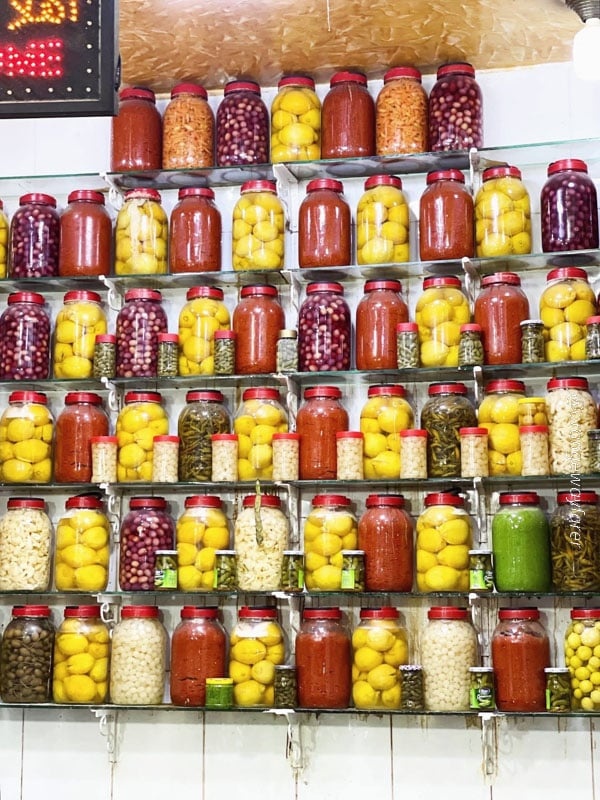
Attarine Souk (spices and perfumes)
Since we were walking aimlessly with a focus to trust the process in Fes Universe, the Medina decided to bring us closer to the Spice market! The Indian in me was elated. The colours the aroma bring memory of home in a faraway land! Taking pictures without actually purchasing is frowned upon!
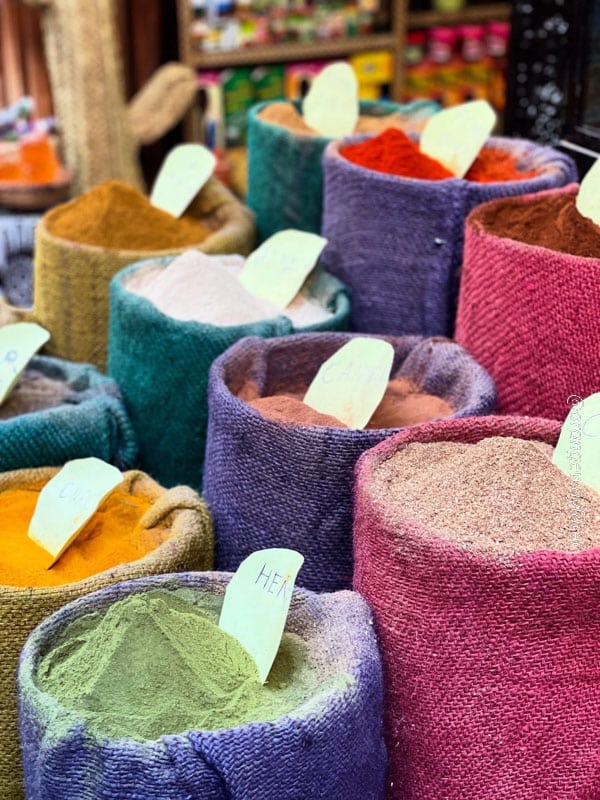
Stay at a Riad when traveling in Fes
Roads stays are my favourite. Especially after our short span of stay in Marakesh. However we chose a Marriot stay over arias for personal reasons (read S wanted to use the Gym). If you are okay to carry your luggage along the cobbled road (for the 10th time, Medina is a car free zone), please opt for a Riad stay. It is wonderful how closing of the iron door transports you to a tranquil world far away from the clamor of Medina!
I would also opt for a cooking class if I have an afternoon to relax in the Riad.

Chouara Tannery
The tanneries of Fes are historic. We can trace their existence in historic books like Rawd Al Qirtas, the historic book of chronicling Fes!
While walking down the Fes streets, we found a bunch of other tourists heading towards an even narrower lane. Something of interest? We walked fast.
Turns out, it was the Chouara Tannery, the one which has all the superlatives to its crown, largest, oldest and the likes.
One of the men caught hold of S’s hand and pulled us out of the sea of tourists and promised us to give the best of the view! Mind you this is at the break of the dawn, we were there at the first thing in the morning.
We walked up spiral stairs of a leather shop, that showcased some of the finest craftsmanship, I would be honest with you. The price point? Pretty steep.
We walked in an air that was filled with the smell of ammonia, decaying organic waste and animal hides. The smell was so potent, we were offered some dried mint leaves.
From the top, we had a clear view of the Tannery. And guess what? It was not the Chourara I have seen on pictures! Although it had all the honeycombed basins laying under sunlight and some under the balcony to escape sunlight that ruins darker hues. I think we climbed one of the rooftops at the southern part and had an obstructed view of the tannery.
However I did not try to reach the northern entrance anymore. The crowd was menacing. I sought for a more intimate experience and opted to go for one of the smaller tanneries of the 3.
We were looking for The Tannery and the tout took us upstairs to show us one of the many tanneries of the localities. Fes had a dozen of them once upon a time, but now only a handful of them remain, namely Sidi Moussa tannery, Ain Azliten tannery and of course the photographers’ favourite -Chourara.
Chourara is well marked on Google maps, but it is possible that you are overwhelmed in the maze, in the stench and with the crowd. Which brings me to the first point, please hire a local guide.
The tannery is housed in between the old buildings which double down as leather product shops. You can go to the rooftops for a small fee, and the expectation is you will buy stuff once you come down. I did not buy anything, and I regret it now! There were boots and bags and belts. And Moroccan drums, the ones we had seen being played under the moonlit night in Sahara desert. The bags reminded me of Shantiniketani slings of West Bengal India! May be it is the camel embroidery!
The impact of this age-old tannery is felt with the stories associated with local’s life here. The manual labour intensive processing methods, the reliance of tourists eyes, and the follow up visit to the stores in lower storeys of the buildings surrounding this tannery is an entire eco system that impacts the lives of the residents of Medina, financially.
The Tannery began operation during the The Idris Dynasty of the 11th century.
We saw workers walking on the stone pits. Soaking leather in designated colour pits.
While Chorara enjoys photographers’ attention, Sidi Moussa on the west and Ain Azliten on the North have far less visitors. The latter has recently undergone renovation, drastically improving the working condition. The dye basins have moved to make space for concrete walls. To reach Ain Azliten, walk along Rue Talaa Kbira, pass through a sheepskin tannery, and proceed towards Ain Azliten.
Traditionally, the tanneries of Fes have used Cow urine, pigeon poop (collected from the walls of Medina) and natural dye to process the animal hides. Had it been a rumored case of cheaper chemical dyes, things would have been sold at a less steep price I assume. The pigeon poop is instrumental in removing fat and hair from the animal hide.
As a part of the Golden caravan route where the deep central African nations would tarde with the North, namely Europe, Fes was one of the stopping points. The caravans carried processed leather and goods from Fes and proceeded further north.
At Ain Azliten, you may come across the living quarters of the workers, which is barely basic, if not dangerous. But it is much more personal and even cordial, albeit with a guide who would help you cross the language barrier. The bright yellow leathers were made exclusively for Moroccan men, I learn. While Ain Azliten can feel a lot more personal experience, Siddi Moussa presents you with a more beautiful photo opportunity, although you may not be get close to the vats. Visitors are not allowed to enter the tannery, unless you convince a guide with a generous tip of dirham.
The other two tanneries of interest in Fes are:
Sidi Moussa tannery
Ain Azliten tannery
Nejjarine Museum of Wooden arts and crafts
Located close to Al Attarine Madrasa, is the Funduq al-Nejjarine, the Caravan serai which houses the private museum of Nejjarine Museum of Wooden arts and crafts.
The carpenters would source the best of Cedar wood from the high atlas, and transform them into things of beauty. Moroccans use these beautiful things for everyday use, from music to furnishing. These are beautiful and meticulously done.
During the Marinid era, Fes excelled in a form of wooden artifacts created by the Najjarin, the carpenters. They had a designated souk. I came across this serendipitous find, a form of art, while looking for the Chouara Tannery.
The carpenters gather across the souk and practice their art form. Small local owned workshops queue that small alley. It is easy to lose your way in Fes, for google maps fail here. I marked the restaurants I saw on the way and stopped by the shop where I wanted to buy my art souvenir from.
You should spend at least an hour here.
I bought a round carving of wood that can double as a wall hanging as well as a windowpane. they had slightly bigger windowpane with intricate wood carving however they were difficult to bring back. This form of art reminded me of the Jodhpur artwork of Rajasthan.
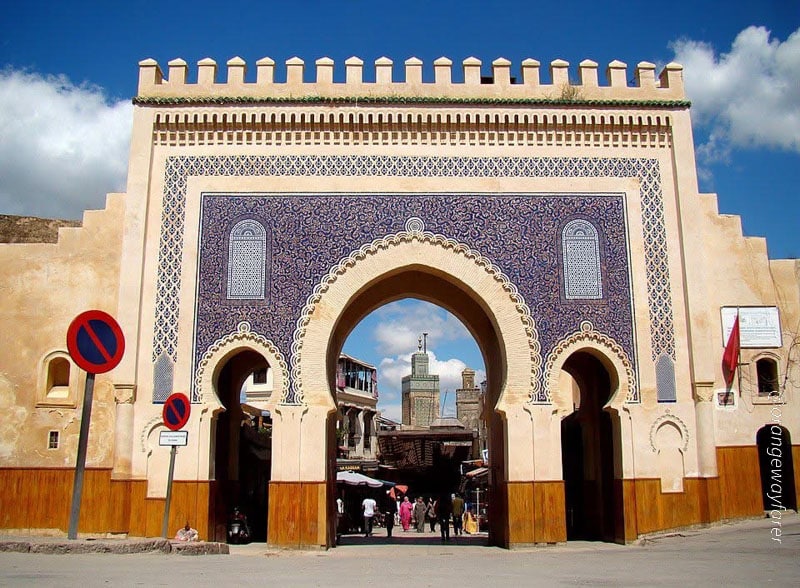
Bab Bou Jeloud Gate
The Old Medina of Fes has an ornate and a relatively elaborate entrance. The French decorated the newer one in comparison to the older, simpler Bab Bou jeloud Gate, which is now restored to its original (and simpler) form as it was in 12th century.
The original old Bab Bou Jeloud gives way to Tala’a Kebira the most populous street of Medina that leads the way to Kairaouine Madrasa. It is also one of the iconic photo spots of Fes Medina.
The new Bab Bou Jeloud Gate was set up in the times of French protectorate. Decked up with the choicest of Moorish Zellij times in polychromic order, the Bab Bou Jeloud strikes up an appearance befitting an entry to the UNESCO world heritage site that old Medina is!
The Blue Gate of Fes, also the grand entry from the West. we reached here at the dark of the night and spotted a few guides at the entrance. You recognise them with a govt ID card dazzling on the chest! Inside the port of entry, you enter the world’s largest car free urban area, lined with shopkeepers selling souvenirs ad a bunch of donkeys toiling for the human owners. The car honks fade way to chatters. The maze that fes Medina is starts!
It is where Bujlood Carnival takes place right after Eid al Adha, where many Amazigh people wear pelt from the animals sacrificed in Eid (read sheepskin) and partake in the festival.
Jnan Sbil Garden
Walking in between the Fes el-Jdid and Fes el-Bali, from the royal citadel to the old city of Fes you will come across the Jnan Sbil garden. The garden plays host to the annual world Sacred Music Festival. I remember a bunch of kittens playing in the bamboo garden section of the landscaped area, that gives a much needed break from the cacophony of Old medina. It is closed on Mnday unlike Medina which would be shut down completely on the day of Jumma (Friday). My favourite part of the park was the oasis like island where palm trees stood still.
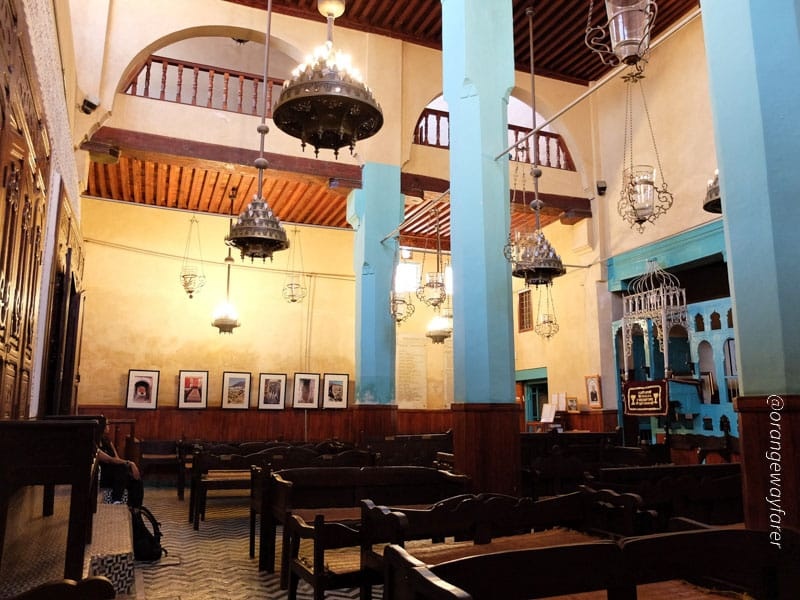
Old Jewish Quarter, Mellah
Visiting Morocco during the war in Gaza has been a interesting experience. The last time I was in the North of AFrica was in 2018. the world politics have shifted and leaned towards stranger arena where violence is increasingly getting normalised.
Morocco is a monarchy, a deeply devout Islamic country. I have seen many appearances of slogans like Free Palentine in Marakesh Medina, even while crossing the Sahara.
The Jews have had to flee Europe multiple times during various Pogroms. The North African countries have given them safe harbor.
The Old Jewish Quarter is one such place, that housed the persecuted Jews population from Europe. The houses are distinct with blue shade on the walls, much like Chefchaouen. Only a handful of people live in the area who fllow Judaism till this day. For a more culturally immerssive experience I would sauggest a visit to the Ibn Danan Synagogue. Strolling through the old Jewish Quarter of Fes would not look very difference than the rest of the Medina, except for a few walls painted with life sized murals and the indigo hues of the wall.
While Morocco has less than 2250 Jews living in the country as of today, the Jewish community had a sprwaling presence during the rule of Sultans, governed by their own Halakha personal law system.
By R Prazeres – Own work, CC BY-SA 4.0, https://commons.wikimedia.org/w/index.php?curid=138695242
The Balconies are often distinct with elaborate wooden work a remnant of Soanish architecture of the communitty named Megorashim (Jews descended from those expelled from Spain).
By Robert Prazeres – Own work, CC BY-SA 4.0, https://commons.wikimedia.org/w/index.php?curid=88728608
Batha Museum
The former palace has been converted to house a number of Moroccan artefacts, intricate jewelry. Housed beside is a calm garden that soothe soul after a hot afternoon stroll at the chaotic Medina!
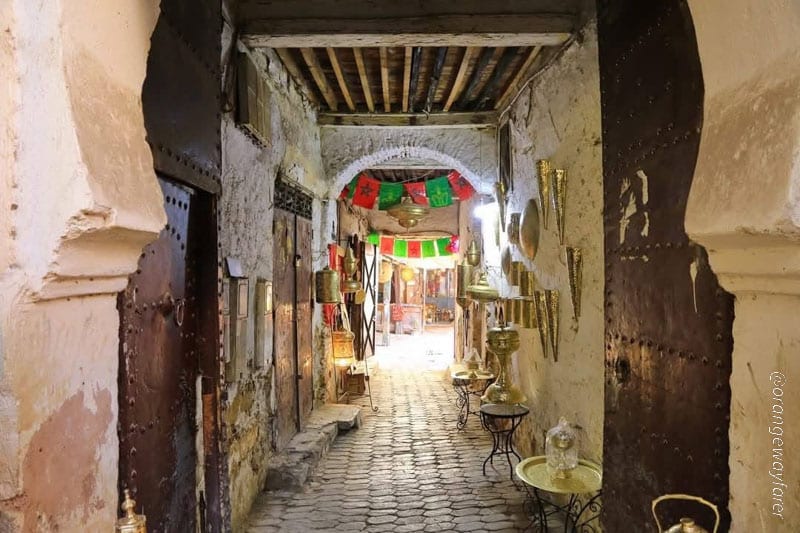
The Roman Ruins of Volubilis
Moulay Idris is a small scenic hillside town that houses the Roman ruins of Volubilis.
The Marinid Tombs
A Necropolis dedicated to the rulers of Marinid Dynasty, the tombs are situated a bit far from the city. I thought this is the perfect place to get a bird’s eye view of the city. You see Fes, without having to struggle through the extremes. Unlike the Medina, the Necropolic had only a handful of people, no hustler asking for tip.
The Royal palace
As one of the most peaceful country with stable political legacy, Morocco will surprise you with its long standing status as a monarchy. While crossing the city of Apple over Hugg atlas , the guide told us the king is from this place. He had said the same thing about Rissani, the market that altered my brain chemistry. No one can enter the royal palace of Morocco. The monarchy runs of secrecy and strict rules. But you can stand in front of the palace and see the doors. If you ask me, more than the doors I found bunch of people standing in front of a door for the King to emerge anytime pretty fascinating. Coming from a democracy, and being a resident of democratic trader of the world, I don’t understand monarchy very well.
Day trip to Chefchaouen
If you have three days in Fes, you can book a day trip to Chefchaouen. The journey would take you through the countryside of Northern Morocco, bring you closer to the verdant valleys and lush greenery of the area. It takes 8 hours for a round trip. After road tripping from Marrakesh to Fes via Sahara, I could not have done it for a whole day without the trip from Get your Guide. I doubted if it was a wise decision to visit Chefchaouen for just a day, but turns out it was worth it! It is so much more than just an Instagram stage!
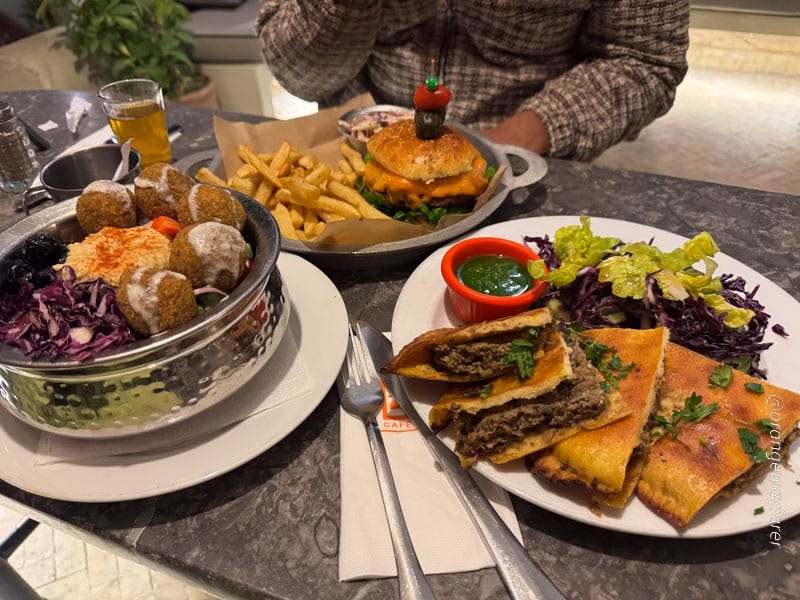
Best places to eat in Fes
The Ruined Garden– Famous for Fassi cuisine (Local cuisine of Fes). I have heard rave reviews of this place. They do serve a mean lamb Tajine. In a world of tagine and couscous, I left my heart in the serving bowl of kofta tagine in ruined garden. The fried sardine was good too, so was Briouate which is a a distant sibling of Indian samosa and of course a star of Fassi cuisine.
Made in M– Great fusion food. Love the Orange Blossom drink. The Chicken Lemon Tagine was very refreshing.
Cafe Clock– While I appreciate the Dromedary Smashburger of Cafe Clock, I really really loved the Falafel balls of this cafe! Not just a rooftop restaurant, it is an icon of Fes. It has now opened a few branches at Marrakesh and Chefchaouen.
Chez Rashid– Arguably the finest Chicken Pastilla in Morocco. Great value for food.
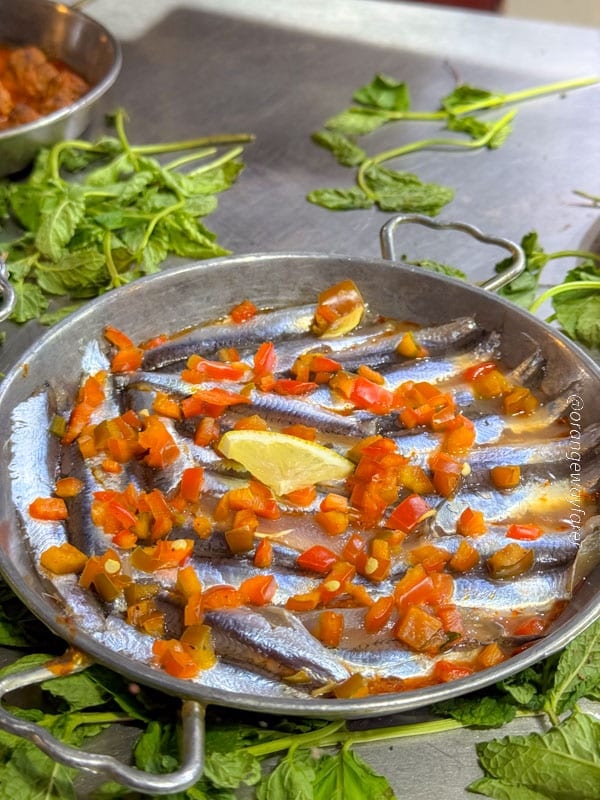
Mouda Palace– Great rooftop setting and serves Moroccan wines! Menu has more options than just tajine. Think rice ball in meat sauce kind of fusion with European mix!
At the hotel we stayed in, Marriot Jnan Palace ,we enjoyed a few dinner dates with nice French food. Think sea bass with caper and likes.
Fondouk Bazaar: the chicken Tajine with saffron couscous is famous here. All the oranges we saw along the way, we had a hearty meal with an orange salad in this place! Must try the spiced coffee and the Tapas plate.
Cafe shop Alaoui: the unassuming place served a delicious Berber omelet which I still dream about!
Restaurant Palais Fes Yahya rooftop: you can easily spend an evening here lounging while the sun sets on the Old Medina. Beautiful ambience and great Moroccan food.
A beautiful restaurant with Moroccan decor that I would like to commend is Tifinar fes restaurant.
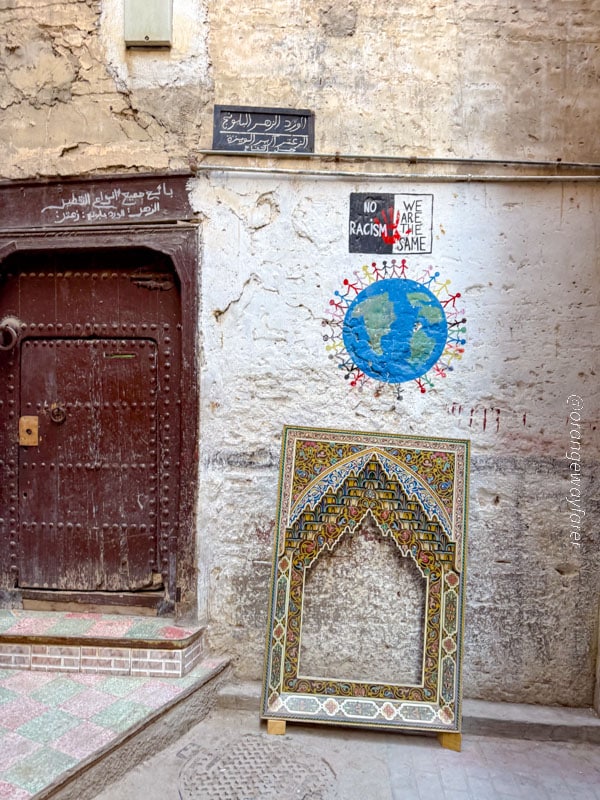
Best Time to visit Fes
From October to March, Fes, like the rest of Morocco has a pleasant weather. The noon is not all about dry scorching heat. There is decent amount of day time to explore places.
On the other hand, it is high season for tourism. Prices would be steeper. Options aplenty. You get the drift. However given Morocco is a dry desert country, and you would certainly want to visit the desert when in Morocco, I strongly recommend you come here during the colder season, if not shoulder season.
Follow along Rue Talaa Kebira: one of the most important routes in Fes stretching from east to West of the city!
Fes was a surprise in my 10 days long Morocco itinerary. Somehow, I had no idea how much the city has on offer, especially after the hype about Marrakesh. While Marrakesh is an easy to fly into city and its close proximity to Essaouira takes away the larger pie from tourism, Fes gets overlooked. I would not lie when I say that’s a good thing.
Fes is bigger, feels more authentic and the Medina has real artists waiting for you to discover! If I go back to Morocco, Fes would definitely be THE stop I would look forward to, as a culturally curious traveler, especially if I am journeying from Europe. Oh, I almost forgot to Mention, Fes is probably the most Camera-friendly city I came across in the North of Africa.
_________________________________________________________
Let’s stay connected on Facebook, Instagram, Twitter, Youtube!
This post may contain affiliate links. Please read the disclosure post. If you have liked the article, you may support it by buying using these links without any extra cost to you.